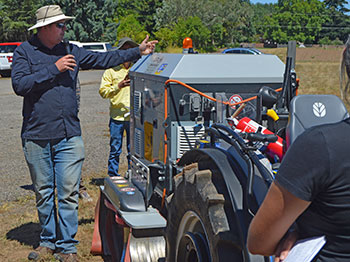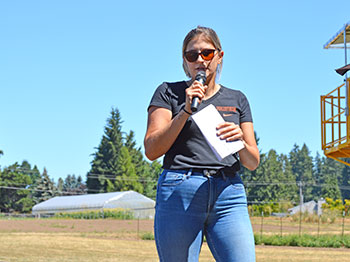Electric Weed Control Now Available in PNW Blueberries
For four years, research into electric weed control in blueberries has been showing promising results. Now, for the first time, machines are available for growers wishing to utilize the technology on their farms, according to Oregon State University weed scientist Marcelo Moretti.
 |
At the OSU Blueberry Field Day, OSU weed scientist Marcelo Moretti announced that electric weed control machines, like the one pictured here, are now available in Oregon and Washington. |
In a presentation at the OSU Blueberry Field Day, July 24 at the North Willamette Research and Extension Center, Moretti unveiled some recent findings and announced that units manufactured by the Swiss company Zasso are now for sale. “I’m happy to tell you that for the first time, in 2024, commercial units are for sale in Oregon and Washington,” Moretti said.
Electric weed control has several uses in blueberry production, Moretti said, including as a non-chemical, no-till weed control option in organic blueberry production, as a means to control resistant weeds and as a means to slow development of resistance in weeds by reducing reliance on chemistries in conventional blueberry systems.
The technology works by using power from a tractor PTO shaft to drive a generator that converts mechanical energy into electrical energy that is converted into high-voltage currents by a transformer. The high-voltage current runs through a plant to its roots, generating heat that ruptures cell membranes.
In researching the technology in blueberries, Moretti started with electric weed control applications in a field of one-year-old Duke plants. The research involved testing the interactions between the technology and different mulches, including sawdust, weed mat and bare ground.
“We applied the electricity to the side of the raised beds or to the side of the plastic and we are evaluating the crop response, the weed control and also the effects in the soil,” said Luisa Baccin, PhD student who helped in the study. The study involved six applications over the course of a year.
“What the preliminary data showed us is that we got great weed control when using electric weed control,” Baccin said, noting the control was ninety percent or better.
“In Canada thistle, we are seeing that with one application at about 1.25 miles per hour we reduce the number of shoots by close to ninety percent. And those shoots did not flower, did not set seeds.”
|
“We also got rate reduction on weed biomass and also reduction on the number of weed species we had in the plots compared to mowing. And we didn’t see any negative impact in the crop or in the soil health indicators,” Baccin said. “So, these results show us that this is a very promising technology, especially for organic production.”
The technology requires a tractor with at least seventy-five horsepower, Moretti said, and the machine can treat up to four feet, or two feet on either side of a row.
As for specific weeds, Moretti said the technology worked well on Canada thistle, yellow nutsedge and several other problematic weeds.
“In Canada thistle, we are seeing that with one application at about 1.25 miles per hour we reduce the number of shoots by close to ninety percent,” he said. “And those shoots did not flower, did not set seeds."
 |
Luisa Baccin speaking at the OSU Blueberry Field Day. |
“And then we dug and looked at the roots and the root viability was reduced by over sixty percent,” Moretti said. “So, after one pass, we’re reducing the number of plants alive. Those plants are not producing seeds and spreading. They’re not producing new buds and spreading locally. And two passes was even better.”
As for nutsedge, Moretti said the technology killed the plants but because it has multiple buds – typically thirteen to eighteen – it tends to sprout a new flush. “That being said, we did make a dent last year,” he said. “So, this is very good on certain perennial weeds.”
Weeds where it is not particularly effective are woody ones, like Himalayan blackberries.
Moretti added that in fields where the technology has been used over the last year, weed growth is down considerably. “We have a lot less weeds, at least fifty percent less. So, that means your weed control costs will be reduced in part because you have fewer passes, lower labor demand and other benefits that are hard to quantify.”
A drawback to the technology is it can start a fire when biomass is dry. But, he said, the technology is a good fit for early in the season, when weeds are actively growing, and biomass hasn’t yet dried. “And then you don’t have to go back later in the season when the biomass is dry. So, starting early is the best option.”